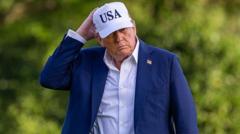In a surprising move, the Trump administration has postponed the rollout of recently threatened tariffs, extending the deadline from Wednesday until August 1, with the likelihood of additional delays. This adjustment informs a larger narrative about the U.S. economic landscape and global trade dynamics, as various countries respond to America's proposed measures. Despite ambitious expectations of "90 deals in 90 days," the reality is starkly different, as it appears the administration's negotiating power is waning.
Trump Postpones Tariffs as Global Trade Tensions Escalate

Trump Postpones Tariffs as Global Trade Tensions Escalate
The Trump administration's decision to delay tariff implementation raises questions amid international trade challenges.
The U.S. focus, highlighted by Treasury Secretary Scott Bessent, remains on 18 key nations contributing to 95% of the trade deficit, yet no meaningful agreements have been secured. The letters being sent to trading partners reflect a return to an earlier strategy, revealing the White House’s ongoing challenges in creating effective trade policies. Notably, both Japan and South Korea have expressed strong frustration with the U.S. approach, hinting at their potential leverage given their significant holdings of U.S. debt.
Market reactions to these developments have been muted but cautious, as investors anticipate the risk of prolonged negotiations. The global trade landscape continues to shift, with China's exports to regions outside the U.S. witnessing growth despite a decline in shipments to the states. This invites speculation on how the landscape may evolve as countries turn to trade among themselves to mitigate U.S. tariffs.
Furthermore, the effective tariff rate imposed by the U.S. has ballooned to approximately 15%, a stark increase from historical rates between 2% and 4%. While tariff revenues have risen, contributing record amounts to the Treasury, it remains to be seen how this impacts domestic pricing and economic stability in the long run. As of now, markets exhibit a level of calm, yet uncertainties loom amidst the ongoing trade conflict and its potential ramifications.
This incident not only exemplifies the current state of international economics but also underscores the risks of unilateral trade policies that may ultimately isolate the U.S. from its traditional partners. A closer look at the evolving situation reveals a pressing need for strategic negotiation to revitalize trade relations in a rapidly changing global economy.
Market reactions to these developments have been muted but cautious, as investors anticipate the risk of prolonged negotiations. The global trade landscape continues to shift, with China's exports to regions outside the U.S. witnessing growth despite a decline in shipments to the states. This invites speculation on how the landscape may evolve as countries turn to trade among themselves to mitigate U.S. tariffs.
Furthermore, the effective tariff rate imposed by the U.S. has ballooned to approximately 15%, a stark increase from historical rates between 2% and 4%. While tariff revenues have risen, contributing record amounts to the Treasury, it remains to be seen how this impacts domestic pricing and economic stability in the long run. As of now, markets exhibit a level of calm, yet uncertainties loom amidst the ongoing trade conflict and its potential ramifications.
This incident not only exemplifies the current state of international economics but also underscores the risks of unilateral trade policies that may ultimately isolate the U.S. from its traditional partners. A closer look at the evolving situation reveals a pressing need for strategic negotiation to revitalize trade relations in a rapidly changing global economy.




















